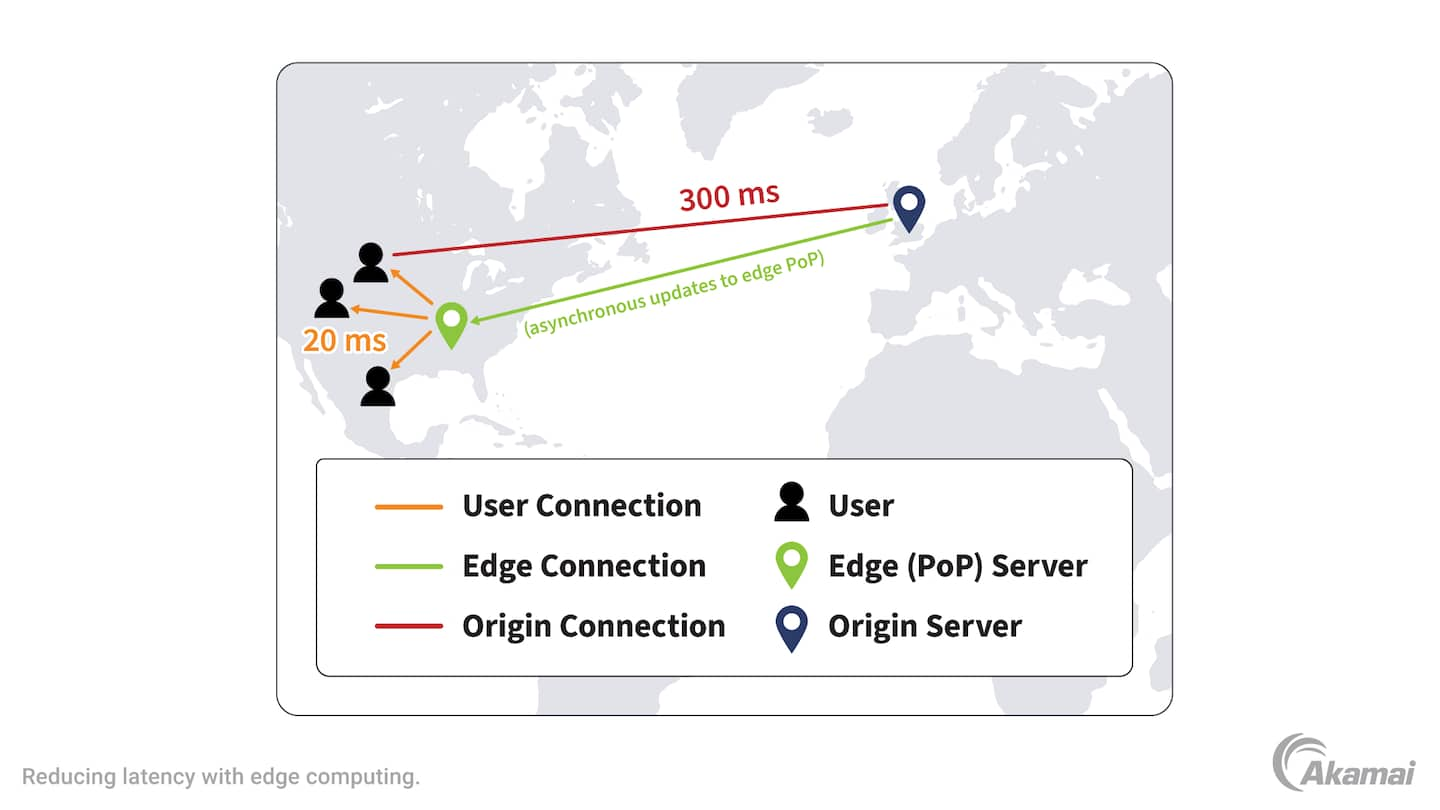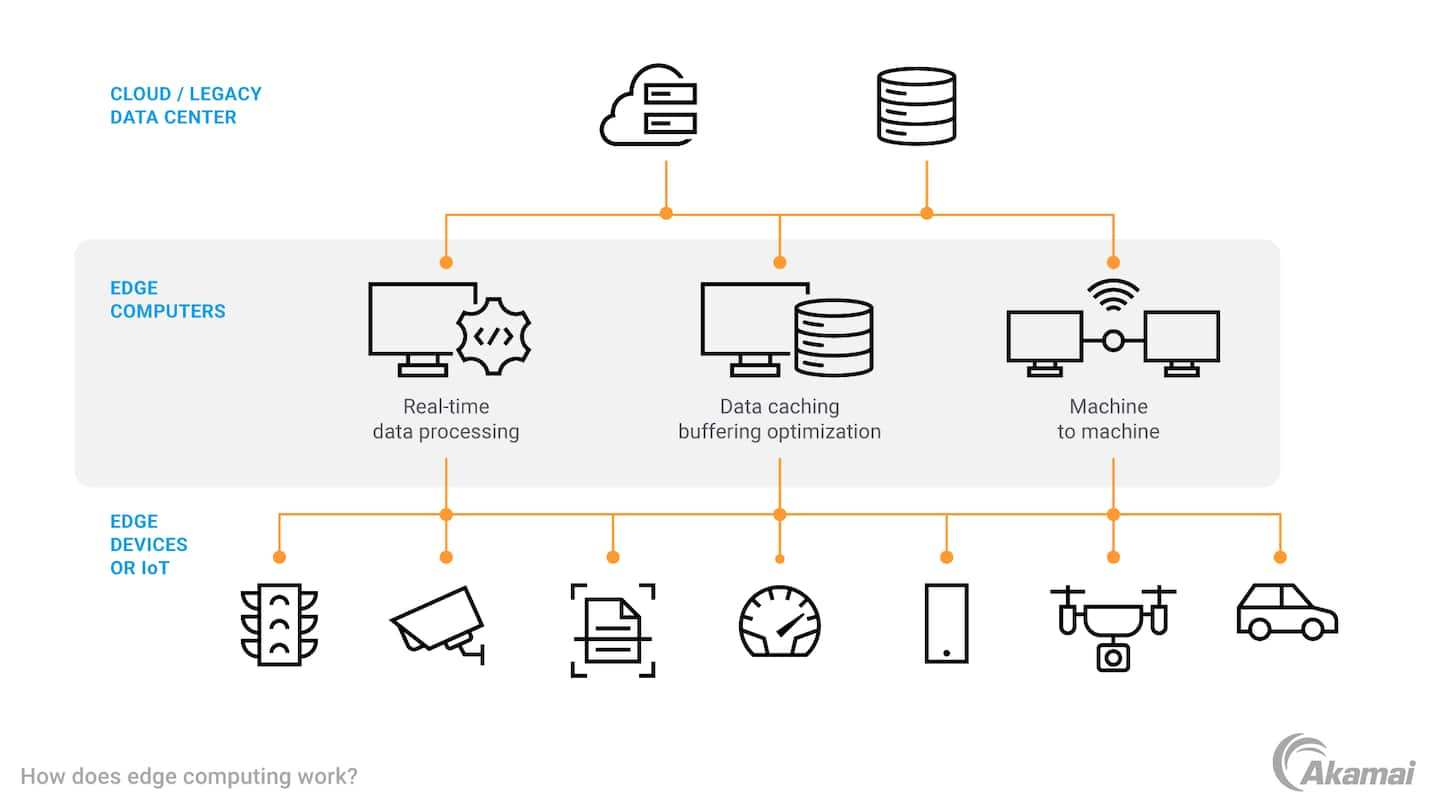Akamai is the cybersecurity and cloud computing company that powers and protects business online. Our market-leading security solutions, superior threat intelligence, and global operations team provide defense in depth to safeguard enterprise data and applications everywhere. Akamai’s full-stack cloud computing solutions deliver performance and affordability on the world’s most distributed platform. Global enterprises trust Akamai to provide the industry-leading reliability, scale, and expertise they need to grow their business with confidence.
The network edge is where the physical and digital world interact — where data is input into or captured by devices that are connected to the internet or a network, and where devices receive data that users and applications rely on for decision-making and insights. Edge computing brings data, insights, and decision-making closer to users and devices, rather than processing data in a central location that may be thousands of miles away. By managing processing at the edge of the network, edge computing ensures that data — especially real-time data — does not suffer latency issues that can impact the purpose or performance of an application.
Edge computing is an IT computing model where data processing and storage functions are moved away from centralized data centers to servers that are physically closer to the network edge, where users and devices access the data. By storing and processing data closer to users and devices, edge computing helps to improve network connectivity, reduce latency, minimize costs, strengthen security, and enhance user experiences.
You can think of edge computing as a doctor’s office with its own lab. Rather than sending samples to a central processing center hundreds of miles away, the doctor’s office has the equipment and bandwidth of time and talent to collect, process, and analyze your blood work right there on the spot, enabling you to get results more quickly and cost-effectively. Since medical samples don’t leave the lab, there’s little chance of them being lost or stolen. And by processing your labs efficiently, the doctor’s office provides a more satisfying patient experience.
Why is edge computing important?
The amount of data that we produce and use each year is growing exponentially. Technologies like the Internet of Things (IoT), artificial intelligence (AI), and machine learning (ML) are generating massive amounts of data. And as billions of devices connect to new 5G networks, this virtual ocean of data will only get larger.
In traditional computing models, an organization’s data is routed through a centralized data center, allowing IT and security teams to manage it, inspect it, and enforce security policies. But as data volumes expand, sending all that traffic to a data center inevitably causes latency and congestion in networks. As a result, users and applications can’t get data fast enough, and users’ online experiences become sluggish and frustrating.
Edge computing meets this challenge by processing and storing data close to where it is generated and used. By keeping data, workloads, and computing functions nearby, edge computing lets data get where it needs to go faster to improve response times, application performance, and user experiences. At the same time, edge computing minimizes congestion on the broader network.
How does edge computing work?
The network edge is where the physical and digital world interact — where data is input into or captured by devices that are connected to the internet or a network, and where devices receive data that users and applications rely on for decision-making and insights. Edge computing brings data, insights, and decision-making closer to users and devices, rather than processing data in a central location that may be thousands of miles away. By managing processing at the edge of the network, edge computing ensures that data — especially real-time data — does not suffer latency issues that can impact the purpose or performance of an application.
To create an edge network, IT teams build computing capacity at remote locations by deploying servers and storage that can quickly process data for nearby devices. Alternatively, data may be processed on memory and storage that’s built into edge devices like laptops, smartphones, and IoT sensors. Rather than sending data generated by edge devices through a central data center or to the cloud, an edge network processes and stores most data on-premises or on nearby edge servers, and only sends essential information to the cloud or to a central data center.
What are edge devices?
Edge devices are endpoints on a network that collect, use, and provide information. They serve as an interface between the real world and the data center or the cloud. Edge devices include the machines we use every day, like laptops, desktops, servers, and routers, along with devices and gateways that are part of IoT networks. Other types of edge devices include medical devices, scientific instruments, scanners, autonomous vehicles, smart displays, point-of-sale terminals, drones, robots, industrial controllers, and even vending machines.
What are examples of edge computing?
Edge computing happens all around us, and continues to grow and expand. Consider the daily interactions you may take for granted when you expect the response to be instantaneous. This spans from tapping on mobile apps, buying things online, checking your bank balance, and streaming media to interacting with a connected device like a light, doorbell, or car — or checking in for a train or flight. All of these services require real-time information processing at massive scale. They are all examples of where edge computing can make the difference between a great experience and a really slow, frustrating one.
Common edge use cases include:
- Gaming. Real-time responsiveness, wait times, matchmaking, and low latency are critical for competitive gaming. Edge computing improves these digital experiences by increasing proximity to players.
- IoT networks. Edge computing solutions allow businesses to take advantage of the power of IoT networks to collect, analyze, and act on massive amounts of data in real time.
- Autonomous vehicles. Self-driving cars produce massive amounts of data that must be aggregated and analyzed in real time, allowing the vehicle to make split-second decisions to deliver riders and cargo to the appropriate destination safely.
- Telecommunications. Edge computing enables telecommunications service providers to modernize their networks and move workloads and services to the network’s edge for superior performance.
- Industrial manufacturing. Manufacturers rely on edge computing to monitor equipment, identify production errors, enable automation, manage robotics, and improve quality through real-time analytics and machine learning.
- Energy. Businesses involved in energy exploration and production use edge computing to collect and store data on oil rigs and gas fields, providing real-time intelligence that can detect hazards, optimize production, improve efficiency, and keep personnel safe.
- Safety applications. From real-time facial recognition at airports to on-site motion detectors and cameras, many safety and surveillance applications benefit from the ultra-fast response times available when data is processed at the edge of the network.
- Healthcare. Edge computing is best able to collect and process the enormous volume of data produced by medical devices and sensors, allowing providers to respond quickly to changes in patient conditions.
- Smart cities. Smart cities use edge computing to power real-time applications like smart traffic lights, smart power grids, smart streetlights, and smart surveillance systems that must be able to process data with split-second response times and superior accuracy.
- Augmented reality (AR) and virtual reality (VR). AR and VR both require real-time processing of large datasets with near-zero lag.
- Artificial intelligence (AI). Edge computing enables AI and machine learning applications to generate, fetch, and process massive volumes of data with greater speed and reliable connectivity.
What are the benefits of edge computing?
To understand its benefits, you can think of edge computing like using your local bank and ATM rather than the bank’s central headquarters in a city hundreds of miles away. Rather than driving a great distance to make a deposit or withdraw cash, you can simply go a few blocks to your local branch, saving you lots of time and money. If all your neighbors do the same, you’ll also reduce congestion on local roads. You’ll also have a more secure experience, since it’s less likely that you will experience car trouble, have an accident, or have your money stolen while you’re driving a few blocks to your local bank.
The benefits of edge computing include:
- Low latency. Latency is that annoying delay you might experience between navigating to a website and waiting for the page to load, or that tap on a mobile app and the extended time it takes to complete an action. This usually happens because data processing and storage are physically far away from you. When these processes are moved to the edge, geolocated near you, near-real-time digital experiences are possible.
- Cost savings. By minimizing network traffic, edge computing helps reduce the costs associated with provisioning sufficient bandwidth, and moving and storing data in the cloud.
- Higher performance. When data is delivered with less latency and quick load times, organizations can count on greater performance from their networks, systems, and applications.
- Better customer experiences. By improving response times and reducing latency, edge computing improves the experience for customers as they engage with websites and applications.
- Data sovereignty. By keeping data local and not crossing national or regional boundaries, edge computing enables organizations to avoid data sovereignty issues and simplify compliance with data privacy regulations in various regions.
- Improve productivity. Edge computing provides users with faster access to data and analytics, enabling them to make decisions and act more quickly.
- Faster decision-making. Faster response times and reliable network connectivity translate to faster delivery of the data that business leaders need to make informed decisions.
- Greater resiliency. By moving data processing to a network of devices and edge locations, edge computing provides redundant paths for transmitting and processing data locally to eliminate a potential central point of failure with centralized servers.
Akamai’s industry-leading edge compute solutions
Akamai provides edge infrastructure for building and running applications and services elastically and with unparalleled scale, reliability, and security. With our massively distributed edge and cloud platform, we are poised to offer the best in edge applications, service computing, and cloud optimization. Digital transformation has never been easier.
- EdgeWorkers provides development teams with capabilities and tools for creating new microservices that leverage Akamai’s platform for secure and fast-acting computation at the edge.
- EdgeKV is a distributed key-value store that allows JavaScript developers to build data-driven EdgeWorkers applications.
- Cloudlets offers tools for running application logic at the edge to deliver better web experiences through robust, self-serviceable apps.
Frequently Asked Questions (FAQ)
Edge computing is an IT architecture where data is stored and processed at the network’s edge, closer to the users, devices and applications that generate and use it. This reduces latency and network congestion to improve response times and enable real-time decision-making. A content delivery network is a collection of geographically distributed servers that store and serve content closer to users to improve response times and enhance user experiences. Both edge computing and CDNs are designed to bring data content closer to the network’s edge. However, CDNs are responsible simply for caching static copies of data, while edge networks store and process data.
Edge computing brings functions like data processing, storage, networking, and security to the edge of the network, relying on a vast array of devices to process and store data close to the users and applications that need it. Cloud computing uses virtualization technology to create vast pools of IT resources in data centers around the world, making compute resources available on demand and accessible via the internet. Cloud computing runs workloads on cloud resources that typically reside in distant data centers, while edge computing runs workloads on devices at the network’s edge.



